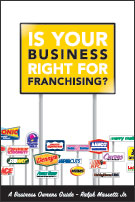|
Call Us Today
5551231234 |
||
|
Contact Us by Email |
||
| Request More Information |

Buy a copy of our CEO's book "Is Your Business Right For Franchising?" on Amazon today.
International Franchise Association (IFA)
Supplier Forum Member

Back to the Future: Why DVD Training is Next
(Franchise-Chat.com) October 29, 2005 -- By Ray Belanger. ©2005 ABA Inc. All rights reserved.One of the biggest hurdles franchises face in bringing training technology into the workplace has always been bulky desktop computers and their need to be hooked up, networked and maintenanced. Take the food service industry for example, rare is the quiet corner where that new computer will be free from flour and grease splatter (not to mention Internet porn and solitaire). Phillips CD-I players were popular training devices in the mid 90s because the portable decks could plug into any TV and provide full interactivity and full screen video. Franchisor Motel 6 invested wisely in the platform as it was a natural for their needs, any unoccupied guest room with a TV became a temporary training room. Despite the wide uptake of the technology by a number of large companies, (including Pepsico), Phillips fumbled the product line with expensive and proprietary software, unpredictable support, and conflicting reports that they were going to discontinue producing the players—which they eventually did.
When CD-ROMs Roamed the Earth
Then came the brief but golden age of the CD-ROM. Interactivity was the most obvious benefit to franchise training, but there were two major drawbacks to the technology, one - the discs weren't big enough to hold video files of any length, and two-developers were constantly wrestling with the operating system (invariably Windows) for permissions to install and run programs or to store information on the user's hard drive. The web seemed like the answer to all these problems when bandwidth started building out in the late '90s, but franchisees still needed a networked PC, a web account, and a quiet area to concentrate—all expensive requisites. So outside of the legion of cubicle workers, the rest of the franchise world (food service, retail, home services) had to get by with print based and classroom training.
Faster, Better, Stronger
Today we have the DVD format which solves a number of these interactive training challenges. Some say the acronym stands for Digital Video Disc; others say Digital Versatile Disc which is a more accurate description. A DVD can hold up to 4.7 gigs of information, over 6 times more than a CD-ROM which can mean over two hours of high resolution full screen video. Because the most common use of DVDs has been to replace VHS as a rental format, DVDs are often overlooked as an interactive training medium. By simply using your remote, you can select content options (much as you select movie scenes), and with the right navigation you can design multiple learning paths on the same disc. You can also have up to 8 audio tracks making alternate languages easily available. Franchisor comments can also be added much as director's comments are added to movies.
One downside however is that the lower resolution of a TV screen makes it difficult to read a lot of text, making this an application better suited to video delivered training. Another price to pay is that there is no way to store user generated data, so every franchisee experience is a new one with no remember me facility, test results, or previous progress details, to move the learner along.
Significant Benefits
But that's the worst of it, from here on in it gets better. The system is completely stand alone and requires only a DVD player and a TV, no web connectivity or operating systems to tangle with, and no computer support necessary. Everyone is familiar with how a DVD player works (it has been the most quickly adopted consumer electronic product in history).
And now for the best part—the costs of distribution are ridiculously low, compared to past platforms. DVD players are under $50 in some cases. And if you want to get rid of your boxy TV monitor, you can get a compact portable player now for under $149. (Wal-Mart) Even that can be plugged into a regular TV if you need a larger image from time to time.
Think back five years ago, how far could your franchise have gone with $150 in your technology rollout budget?
Portability becomes an advantage with compact players as well; they can be used anywhere with earphones for privacy, and even booked out for the weekends by employees who want to train at home. (And if the kids want to watch Shrek in the back seat - do we really care?)
The cost of creating DVDs, or authoring as it is called, is also very low, especially if you have existing video that you want to re-deliver in this format. The costs of producing new video have also declined significantly, more so if you can resist the creeping elegance often encouraged by Hollywood-frustrated video producers.
Practical Applications
So what are franchisors to do with this new gadgetry? Consider these scenarios. An automotive technician is about to install an after-market accessory, something which he has limited experience in doing. He puts his compact DVD player on the dashboard of the car, selects the particular product from the menu, and follows the step by step video instructions on the screen.
A new hostess starts work at a full service restaurant, the day before her first shift she is given a DVD to take home. She pops it into her home player and receives a full orientation to the franchise, her job responsibilities, quality standards etc. She shows up for work the next day, fully prepared to begin work immediately.
A franchise sales rep is traveling out of town to make a presentation, before she leaves, she signs out a compact DVD player and a copy of the new sales training program the company is implementing. She reviews the DVD on the plane, and takes advantage of the quiet time to absorb the program's content. Portability, interactivity, low cost, all make this an attractive platform for franchise training and development.
Looking back to the promised future of a few years ago, the benefits of technology based training have taken a long time in coming. Who back then could have predicted that it would be the entertainment industry, not the training industry, which would drive the adoption of DVD players, and in doing so create an efficient training mechanism that's available to franchisors everywhere?

